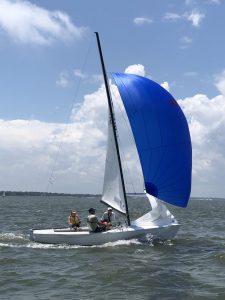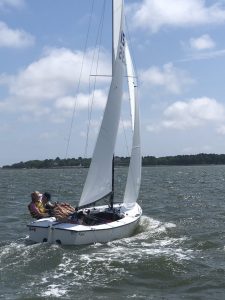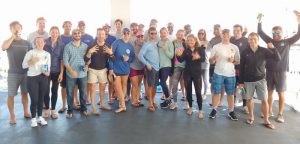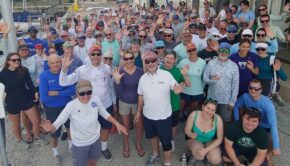Success in promoting the Lightning
Published on January 21st, 2020
The past decade has seen the introduction of many new one-design boats, but this leaves many yacht club parking lots and boat slips filled with different types of boats, fragmenting sailors into smaller one-design fleets. Despite a changing sailing world, the 82-year-old Lightning Class has continued to thrive as the largest, most active multi-crew one-design in the world.
At the highest level, the fleet is deep and competitive, with between 70 and 110 boats regularly competing in the North American championships and featuring multi-class sailing greats Jody and David Starck, Ched Proctor, Skip Dieball, Matt and Greg Fisher, and David Dellenbaugh, to name but a few.

The Lightning Class has enjoyed remarkable success in growing the participation and enthusiasm of sailors under 35 years old, bolstering the class’s strong fleet and positioning it for a promising future. At last year’s North Americans, there were over 70 sailors under 35 years old, including 10 out of 35 skippers in the Championship Fleet.
These numbers are paralleled at all major Lightning events, and the Lightning Class’s Junior North American Championship consistently draws 20+ boats, including each of the past two years. The Boat Grant and Legacy programs have been instrumental in encouraging this youth participation and attracting top young sailors.
The Boat Grant Program provides 2-6 recipient teams annually with a competitive boat and sails; funds for costs associated with regatta fees, boat insurance, and travel; and a top sailor as a mentor. The Legacy Program sells donated, competitive Lightnings at a significant discount to young sailors looking to enter the class.
Thirty eight teams, 114 sailors total, have received the Boat Grant in its 12 years of existence, and 12 skippers have gone on to purchase Lightnings, with many more active as crews or planning to purchase a boat in the future.
However, this understates the impact the program has had. Word of the social, competitive nature of the class is spreading among young sailors, and Boat Grant recipients are helping to bolster fleets and draw others organically into the class.
Exemplifying this trend is Ryan Davidson, a sailor from Newport Beach, California who competed for College of Charleston. He received the Boat Grant in 2018, bought a boat through the Legacy Program shortly after, and helped reinvigorate the Charleston Lightning fleet—which now has four new boat owners under 32 years old. Here are some thoughts from Ryan on his Boat Grant and Lightning experience.
Can you share your background, including boats you grew up on and what type of sailing you did?
I grew up sailing in Southern California at Balboa Yacht Club. We sailed Naples Sabots from San Diego up to Long Beach. Long live the leeboard! After sabots, I sailed CFJs and C420s. At BYC we hosted the Governor’s Cup youth match racing event where I was introduced to three-person boats.
We spent six years campaigning in match race regattas around the world and were able to sail the Sears Cup (youth triple-handed US Championship). At the College of Charleston (’16), I sailed on the match race team in 3-4 person keelboats. Since then, I’ve sailed on small keelboats in fleet, team, and match racing.
How did you hear about the Boat Grant and what made you interested you in pursuing the program?
Past recipients Jeff Aschieris, Ben Spector, and Sam Stokes first introduced the boat grant program to me in 2014. Since then, I have had many friends receive the grant. Seeing how much fun they had and watching them compete at the highest level around the country made it an easy decision for me. It also helps when Greg Fisher is the Director of Sailing while you are in college, and he tells you all the stories from his Lightning career.
Can you describe the application process?
The process was very straightforward. Fill out an application as a team and select the regattas you plan to attend. The committee then schedules a phone interview.
What did you think about the class and the competition?
Ever since the first day of getting the boat grant, I have felt part of the class. The local Charleston fleet especially has been extremely welcoming and helpful, making sure we were up to speed and the boat was set up right. This last year I have met life-long friends. In particular, I met a group of friends at the North Americans that I know I’ll be friends with, and competing against, forever.
Can you describe the demographic of the class?
The Lightning Class is special because of the demographics. There are youth sailors (ages 14-20) and sailors in their 80s, and everything in between, and you never know who will come out ahead. Lenny Krawcheck has been a mentor to me. He has been competing in the class forever and I don’t see an end in sight for him. A lot of other classes right now seem to be made of sailors my age to their mid 50s.
It is awesome to see how many females are sailing Lightnings. I think having the Women’s, Juniors’, and Masters’ North American Championships is a huge plus. This keeps the class inclusive for any sailor who is interested. And to see how many families have generations of sailors competing together, it’s awesome.
What about the social aspect of the class?
There are people that I have met in the class that will be life-long friends and I have seen old friends for the first time in a very long time. The class doesn’t have to throw social events after racing, they just happen because everyone loves being around each other off the water.
What was the learning curve like in the Lightning?
The learning curve, like most boats, is very steep. I know there is still some much for me to learn, but aligning myself with strong mentors in the class have helped a lot. I got to participate with the PamAm team last spring. Doing a three day training session with Jody Stark, Skip Dieball, Ian Jones, Matt Fisher, Greg Fisher, Jo Ann Fisher, Lenny Krawcheck, and many others was huge. Listening to the discussions they had off the water were huge for my education.
You’ve had an amazing year finishing seventh in North American’s, second in the South American’s and third at the Wild Oyster regatta. What was key in these finishes?
It’s because of training weekends. Greg and Jo Ann Fisher have been a huge help in the recent sailing I have done. But even more so, I have had some rockstar crews to drag me around the course. The Lightning truly is a team boat. For all the Charleston summer events I got help from different crews at each event.
At the NAs, I had Timmy (Timothius) Crann and Jo Ann with me. Both of them drove the boat from their respective positions. At the Wild Oyster, Kathryn Moloney sailed with Timmy and me and they were the real brains of the operation. At the SAs, Timmy and I sailed with Laura Jeffers, a rockstar Lighting veteran. All of these crews knew exactly how to make the boat go fast and together we picked the right places to go on the course.
What was it like going to Peru?
When Laura [Lightning Class Executive Secretary] texted me asking “do you have a passport and can you get work off these days?” How can you say no?! This was a trip of a lifetime and we have to thank the Lightning class and US Sailing for making it happen. This was my first experience sailing in a country with a foreign language. On top of that, the Lightning class proved how cool it was because of people like Jaime Calderon, who was the best host an international team could have asked for.
You’ve “bought into” into the class and are the first true Legacy member of the class; can you describe that?
I can easily say that without the Legacy program, I would not be a Lightning owner. There are so many people my age who come out of college that are looking for a class to join. We all come out of college sailing and are use to tight racing every weekend.
There are so many classes out there now that race every weekend, but there are very few who participate in a boat grant program. And even fewer who offer a legacy program helping you “buy into” the class. I think that is part of the reason why the Lightning class is so strong to this day.
You’ve had opportunities to race in other classes that are arguably some of the highest performance in the country and yet you are a real member of the Lightning class. What is the reason?
I love the Lightning because of how technical it can be, but at the same time, how easy it can be to set up. With North offering two different and competitive cuts, there’s a wide range of different ways to set up the boat. The extremely technical person who likes to tweak every little thing feels welcome. But at the same time, the person who just wants to hop in a boat and sail by feel is just as welcome.
To summarize what I’ve been talking about before, the class is extremely diverse and competitive. The class makes the barrier to entry very minimal. And the other Lightning class members are what make the class even better. I love this class and can’t wait for future regattas.
Aside from the friendly, competitive fleet, these programs have been successful in encouraging youth participation due to the Lightning’s combination of performance and accessibility. The Lightning carries a simple, low-cost rig but highly technical sail shape controls. The hard chines and 130lb steel centerboard allow stable planing in heavy winds with a large spinnaker, but it remains easily trailerable. Top sailmakers are constantly updating sail designs, but sails are a fraction of the cost of newer high performance boats.
 Most importantly, older boats can compete at top events. Their durable design allows decades of performance (a 26 year old Lightning won the World Championships in 1995), and a competitive used Lightning can be purchased for $10-15k even outside of the Legacy Program, making them reasonable to acquire for a college graduate.
Most importantly, older boats can compete at top events. Their durable design allows decades of performance (a 26 year old Lightning won the World Championships in 1995), and a competitive used Lightning can be purchased for $10-15k even outside of the Legacy Program, making them reasonable to acquire for a college graduate.
Hard-working volunteers in the Lightning Class, starting with its creators, Bill Fastiggi and Allan Terhune, in 2007, have facilitated the success of the Boat Grant and Legacy programs. None of this would have been possible without the generous class members who have donated time, money, and boats, and the current chairs, Matthew Schon and Greg Fisher.
More detailed information about the ILCA Boat Grant Program can be found here.
To learn more about the Legacy Program, email office@lightningclass.org
Source: Tanner Probst










 We’ll keep your information safe.
We’ll keep your information safe.